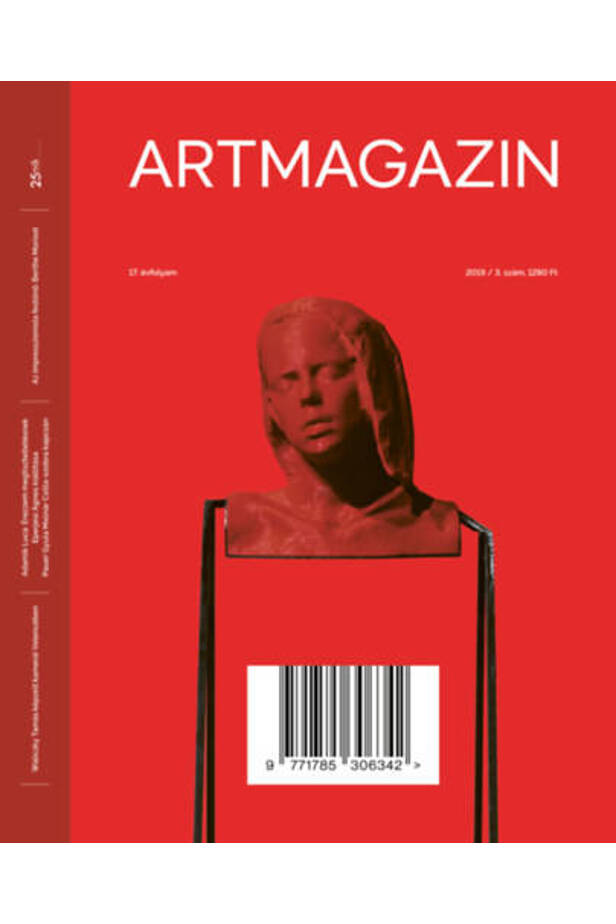Artmagazin 114 - 2019/3.
Delivery time: 2 - 3 business days
Quantity:
HUF 1,190
Description
Artmagazin's articles are published in the field of contemporary and classical art, focusing on Hungarian and international events, research, trends and trends. Our interest extends to border areas: fashion and design are as much a topic here as the connection points between theater, architecture and music. ARTMAGAZINE 114. Our June issue was compiled in the spirit of a past correction. On our cover is a work whose layers of meaning can be unraveled for many years to come as newer and newer ones are deposited on it. As unusual as it is for a red, 3D-printed girl’s head, this statue is one of the most important monuments in the country. As there was a statue of Petőfi in almost every city, when the heroic death of a young man for patriotism was at the top of the values, now Csilla Molnár, the winner of the first Hungarian beauty queen election after 1945, later committed suicide seems to be the most adequate symbol, especially if the statue is completed we take: the conditions under which the plaster sample was made of a 16-year-old girl in 1985, on the basis of which bronze was cast, that the statue of Gyula Pauer finally went to the National Gallery, but it was not exhibited that Ágnes Eperjesi dressed this bronze For an exhibition in a gallery, she made a monument to the Queen of Beauty directly referring to the Nefertiti of Little Warsaw. Of course, we owe it to Gyula Pauer that the period, the period of the change of regime, had an imprint that could be interpreted, dressed up, set aside or exhibited. That it was preserved for eternity. Due to the way in which the head now used by Prešov preserves the type of suffering saints and tombstones, it will be suitable for expressing the general feminine-human feelings even if the story of Csilla Molnár erodes from it at some point. Our article about this year's Hungarian participant at the Venice Biennale reveals how Tamás Waliczky outlines the possibilities of retrospective possibilities in the thought experiments that ultimately show different phases of the technological development and the object-making process, like the Back to the Future films. . The graphics of János Sugár in the eighties are also strangely related to time, we know that Sugár's ambition was to depict the world twenty years later. Or at least imagine your own age the way you think you would do it twenty years later. And for the interpretation of Antal Lakner's works, it is good to know that while amazing technological developments are taking place so that our little finger does not have to be moved in the future, another sphere, artists, is already working on how to remedy the problems that are expected. The invention and operation of the Fortepan archive is also a past correction. We got amazing knowledge because someone had the idea to save the image that had accumulated due to photography and was sentenced to be thrown out of their brains, and they created the conditions for joint recycling. It is a simpler case when the forgotten or lost works of oeuvres come to light and are embedded in the public consciousness than with the paintings of an Italian painter, Jakab Marastoni, who made a career in Hungary. Or let’s take a look at what’s happening right now in America, the largest consumer-consuming country in Impressionism, with a painter who has hitherto been pushed into the background and who has only recently received as much light as her male counterparts. We are also writing about the reorganization of a permanent exhibition, which will change our image of turn-of-the-century Vienna and how modernism was born. Finally, our knowledge of whether there was or is feminist art in Hungary is rewritten with the help of a book. However, we also recommend the illustrations of this issue in this respect: in this respect, the subtitle of this issue could also be: from the Greek woman of Ildikó Várnagy's escape from Paradise, which has now been destroyed, from the Greek woman of Jakab Marastoni. Contents Artanzix Biennale Szilágyi Róza Tekla: Complaints of the Pseudo-Beach Biennale Schneider Ákos: Machines for Fantaz Machine Tamás Waliczky Tamás Vécsárák Exhibition Store Zsanett: The Future Home Lakner Antal in the Timisvár Art Encounters Esszé Geskó Judit: Experimental or Cognitive János János Duplicated Graphics Interview Topor Tünde - Nóra Winkler: I AM A GREAT BELIEVE IN THE INITIATIVES USING THE STRENGTH OF THE COMMUNITY Conversation with István Virágvölgyi, curator of the Fortepan exhibition WOMEN'S BURNS About Erzsébet Tatai's "feminist reading book" Collectors, collections Gábor Ébli: THE GREAT RETURN Exhibition series from the Böhm collection Little-known oeuvres Jenő Murádin: ROAD SIGNS AMI Berthe Morisot Exhibition in Dallas ARTANZIX
| publisher | Artmagazin Kft. |
|---|---|
| scope | 80 |
| volume unit | oldal |
| ISBN | 9771785306342 |
| year of publication | 2019 |
| binding | pur adhesive bonding |

Sign up for our newsletter and be the first to know!
A Zamnia hírlevélre való feliratkozással megerősítem, hogy betöltöttem a 16. életévemet.


